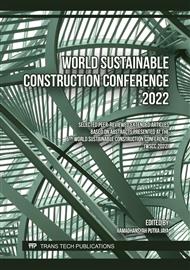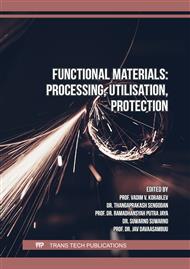[1]
K.S. Kumar and S.D. Babu, A study on performance of self compacting concrete with mineral admixtures, Indian Journal of Science and Technology. Vol. 8 (32) (2015).
DOI: 10.17485/ijst/2015/v8i32/87290
Google Scholar
[2]
P. Ramanathan, B. Bose, P. Muthupriya, and Venkattasubramani, Performance of self compacting concrete containing different mineral admixtures, KSCE Journal of Civil Engineering. (2013) 17 (2): 465-472.
DOI: 10.1007/s12205-013-1882-8
Google Scholar
[3]
K. Khayat, Workability, testing, and performance of self-compacting concrete, ACI Materials Journal. V. 96, No. 3, May-June 1999.
Google Scholar
[4]
D.Z. Alias Tudin, A.N. Rizalman, and H. Asrah, Performance of palm oil fuel ash and rice husk ash based geopolymer mortar, E3S Web of Conferences. 65 02011(2018).
DOI: 10.1051/e3sconf/20186502011
Google Scholar
[5]
A. Arif, H. Asrah, A.N. Rizalman, and S. Dullah, The properties of blended cement containing palm oil fuel ash, IOP Conf. Ser.: Mater. Sci. Eng. 495 012092 (2019).
DOI: 10.1088/1757-899x/495/1/012092
Google Scholar
[6]
B. Sibin and A.N. Rizalman, Study on the preparation of eggshell powder as a partial cement replacement in mortar, International, Journal of Advanced Research in Engineering Innovation. v. 3, n.1, pp.43-52, mar. 2021.
Google Scholar
[7]
M.D.B.A Rauf, A.N. Rizalman, and B. Sibin, Performance of binary and ternary blended cement concrete containing eggshell and silica fume, Research & Innovation Poster Competition. page 27.
Google Scholar
[8]
H. Awang, M.N. Atan, N. Zaibul Abidin, and Y. Yusof, A cost-reduction of self-compacting concrete incorporating raw rice husk ash, Journal of Engineering Science and Technology. Vol. 11 No. 1 (2016) 096-108.
Google Scholar
[9]
M.A. Tambichik, A.A. Abdul Samad, N. Mohamad, A.Z. Mohd Ali, M.A.O. Mydin, M.Z. Mohd Bosro, and M.A. Iman, Effect of combining palm oil fuel ash (POFA) and rice husk ash (RHA) as partial cement replacement to the compressive strength of concrete, International Journal of Integrated Engineering. Vol. 10 No. 8 (2018) pp.61-67.
DOI: 10.30880/ijie.2018.10.08.004
Google Scholar
[10]
M.A. Alnahhal, U.J. Alengaram, M.Z. Jumaat, M.A. Algedra, H.M. Kim, and M. Sumesh, Evaluation of industry by-products as sustainable pozzolanic materials in recycled aggregate Concrete, Sustainability. (2017) 9 767.
DOI: 10.3390/su9050767
Google Scholar
[11]
M. Mallesh, Sharanabasava, K. Reena, and Madhukaran, Experimental studies on M25 grade of self compacting concrete, International Research Journal of Engineering and Technology (IRJET). Vol. 6 Issue 9 Sep-2015.
Google Scholar
[12]
H. Mohammadhosseini, A.S.M. Abdul Awal, and A.H. Ehsan, Influence of palm oil ash on fresh and mechanical properties of self-compacting concrete, Sadhana. 40 (6) (2015).
DOI: 10.1007/s12046-015-0426-y
Google Scholar
[13]
M. Safiuddin, M.M. Rahman, M.A. Salam, M.H. Md Isa, and M.Z. Jumat, Properties of self consolidating palm oil fuel ash concrete, Advanced Science Letters, Vol. 5 1-8 (2012).
DOI: 10.1166/asl.2012.4268
Google Scholar
[14]
B. Alsubari, P. Shafigh, Z. Ibrahim, M.F. Alnahhal, and M.Z. Jumaat, Properties of eco-friendly self-compacting concrete containing modified treated palm oil fuel ash, Construction and Building Materials. Vol. 158 January 2018 Pages 742-754.
DOI: 10.1016/j.conbuildmat.2017.09.174
Google Scholar
[15]
A.N. Rizalman, Y.S. Hii, S.M.I. S. Zainal, and N.S.H. Harith, Effect of water-binder ratio on properties of self-compacting concrete containing palm oil fuel ash, International Journal of Advanced Research in Technology and Innovation. Vol 4 No 1 28-34 (2022).
DOI: 10.55057/ijarti.2022.4.1.4
Google Scholar
[16]
M. Safiuddin, M.H. Md Isa, and M.Z. Jumaat, Fresh properties of self-consolidating concrete incorporating palm oil fuel ash as supplementary cementing material, Chiang Mai J. Sci. (2011) 38(3) 389-404.
DOI: 10.32920/14638200
Google Scholar
[17]
M. Amran, G. Murali, R. Fediuk, N. Vatin, Y. Vasilev, and H. Abdelgader, Palm oil fuel ash based eco-efficient concrete: a critical review of the short-term properties, Materials. (2021) 14, 332.
DOI: 10.3390/ma14020332
Google Scholar
[18]
J. Pone, A. Ash, J. Kamau, and F. Hyndman, Palm oil fuel ash as a cement replacement in concrete, Mod App Matrl Sci. 1(1) (2018).
Google Scholar
[19]
W.A. Saffuan, K. Muthusamy, N.A. Mohd Salleh and N. Nordin, Properties of concrete containing ground palm oil fuel ash as fine aggregate replacement, IOP Conf. Series Materials Science and Engineering. 264 (1) (2017) 012008.
DOI: 10.1088/1757-899x/264/1/012008
Google Scholar
[20]
B.H. Nagaratnam, M. Abdul Mannan, M.E. Rahman, A.K. Mirasa, A. Richardson, and O. Nabinejad. Strength and microstructural characteristics of palm oil fuel ash and fly ash as binary and ternary blends in self-compacting concrete, Construction and Building Materials. 202 (2019) 103-120.
DOI: 10.1016/j.conbuildmat.2018.12.139
Google Scholar
[21]
S.A. Zareei, F. Ameri, F. Dorostkar, and M. Ahmadi, Rice husk ash as a partial replacement of cement in high strength concrete containing micro silica: evaluating durability and mechanical properties, Case Studies in Construction Materials, Volume 7 (2017) Pages 73-81.
DOI: 10.1016/j.cscm.2017.05.001
Google Scholar
[22]
S. Rukzon and P. Chindaprasirt, Use of rice husk-bark ash in producing self-compacting Concrete, Advances in Civil Engineering. Volume 2014 Article ID 429727.
DOI: 10.1155/2014/429727
Google Scholar
[23]
G. Sua-iam and N. Makul, Utilization of limestone powder to improve the properties of self compacting concrete incorporating high volumes of untreated rice husk ash as fine aggregate, Construction and Building Materials. 38 (2013) 455-464.
DOI: 10.1016/j.conbuildmat.2012.08.016
Google Scholar
[24]
G. Sua-iam and N. Makul, Utilization of high volumes of unprocessed lignite-coal fly ash and rice husk ash in self-consolidating concrete, Journal of Cleaner Production. 78 (2014) 184-194.
DOI: 10.1016/j.jclepro.2014.04.060
Google Scholar
[25]
M. Abdul Rahim, N. Mohammad Ibrahim, Z. Idris , Z. Md Ghazaly , S. Shahidan, N. L. Rahim, L. Ahmad Sofri, and N.F. Isa, Properties of concrete with different percentage of the rice husk ash (RHA) as partial cement replacement, Materials Science Forum. Vol. 803(2015) pp.288-293.
DOI: 10.4028/www.scientific.net/msf.803.288
Google Scholar
[26]
R.K. Sandhu, and R. Siddique, Influence of rice husk ash (RHA) on the properties of self compacting concrete: a review, Construction and Building Materials. Volume 153 (2017) pages 751-764.
DOI: 10.1016/j.conbuildmat.2017.07.165
Google Scholar
[27]
N. Bheel, S.L. Meghwar, S.A. Abbasi, L.C. Marwari, J.A. Mugeri, and R.Z. Abbasi, Effect of rice husk ash and water-cement ratio on strength of concrete, Civil Engineering Journal. Vol. 4 No. 10 (2018).
DOI: 10.28991/cej-03091166
Google Scholar
[28]
A.E. Abalaka and O.G. Okoli, Influence of water-binder ratio on normal strength concrete with rice husk ash, International Journal of Sciences. Volume 2 (2013).
Google Scholar
[29]
V. Sata, C. Jaturapitakkul, and K. Kiattikomol, Influence of pozzolan from various by-product materials on mechanical properties of high-strength concrete, Construction and Building Materials. Volume 21 Issue (7) (2007) 1589-1598.
DOI: 10.1016/j.conbuildmat.2005.09.011
Google Scholar
[30]
A.M.H. Rashid, M.K.A. Molla, and C.T.U. Ahmed, Long term effect of rice husk ash on strength of mortar, International Journal of Civil and Environmental Engineering. 4 (7) (2010).
Google Scholar



